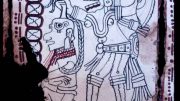The Andean condor is the largest raptor in the world. Adults weigh between 20 to 30 pounds and can reach a shocking 1.2 metres in height with a wingspan of up to three metres! Condors are a type of vulture and thus they feed primarily on dead or dying animals. They will also feed on young or injured animals and raid nests for eggs. Eating is not just a disorganized mess of gut-pulling; the dinner table is remarkably structured with the oldest, dominant male feeding first, followed by all other males, then females and young.
Scavenging for a meal by poking your head into rotting carcasses whenever possible is not conducive to good hygiene and this is why the heads of vultures are bald. The Andean condor may travel over 300 kilometers per day looking for food. They can soar at altitudes of almost 5,500 metres using thermal gusts to save energy. They also save energy by allowing their body temperature to drop several degrees below normal at night. Keeping one’s body temperature up to snuff is shockingly expensive.
Andean condors are New World vultures that are more closely related to storks than to African vultures. They are the only New World vulture to show sexual dimorphism; the males are larger than females and have big fleshy crests on top of their heads as well as a white collar of feathers around the neck. Females have bright red eyes. This condor does not have a “voice box” and so it is usually silent. They make weird hissing, clucking or barking type sounds during courtship, at which time males try to impress females by prancing around with their massive wings outstretched. They mate for life and may live as long as 75 years in captivity.
Both parents take turns incubating the eggs as well as raising and feeding their young.
Breeding usually takes place every second year, or not at all if food and/or weather conditions are poor, and only one egg is laid. Young do not leave their parents until their second year and do not reach sexual maturity until about six or seven years of age.
How about a simple mathematical problem to ponder? Assume a 100 per cent survival rate where all young birds survive to adulthood and are themselves able to reproduce. Assume that the point of reproduction is not in fact for pleasure but to replace one’s self and spread ‘dem lovely genes. If two birds produce one bird every other year, how long would it take to guarantee they replace themselves and thus maintain a stable Andean condor population? The answer, in a perfect world, is four years and last I checked it was not a perfect world. Andean condors have in fact fallen upon hard times.
The Andean condor is thought to be hands down the largest flying bird that exists in the world today. What have we got to compete against that? Big brains? Pah! Perhaps then jealousy is the reason for this incredible animal’s addition to the U.S. Endangered Species list in 1973.
More practical reasons might suggest things like over hunting, deforestation, loss of habitat and pollution. Andean condors breed relatively well in captivity and many young have been released back into the wild since the 1990s. Radio tracking has shown that many of the released birds have survived to maturity and have themselves begun to reproduce in the wild.
However, they are still listed as endangered. Andean condor feathers have been used to ward off nightmares, as cigarette holders and by harpsichord makers for . . . something. Other body parts have been used by various people for different reasons. Their bones have been ground to soothe rheumatism, their stomachs have been eaten to cure breast cancer and their eyes have been roasted to improve human sight.
Now let’s all dig out our Much Music Dance mix cds of the 90s and celebrate tentatively. Or you might want to look up the San Diego zoo for more information on their captive breeding and wildlife reintroduction programs.



